Abstract
Exposure of growing cells to low levels of N-hydroxyurethan (approximately 0.05 m) resulted in loss of colony-forming ability. This was accompanied by degradation of cellular deoxyribonucleic acid. When the concentration of N-hydroxyurethan was increased to 0.2 m, bacteriostasis was the primary manifestation. The lethal action of the drug was prevented by contreatment with chloramphenicol or azauracil or by uracil-deprivation of a bacterial strain requiring this pyrimidine for growth.
Full text
PDF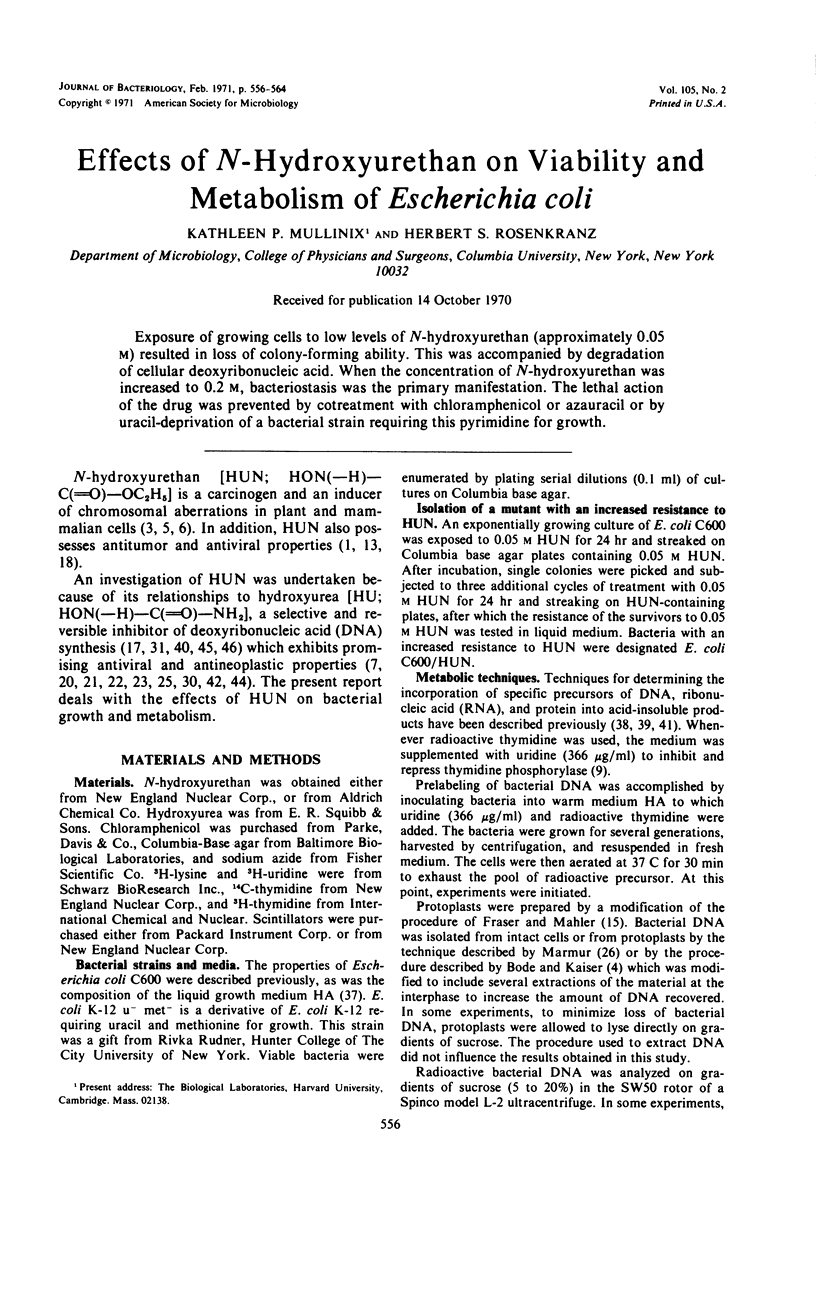
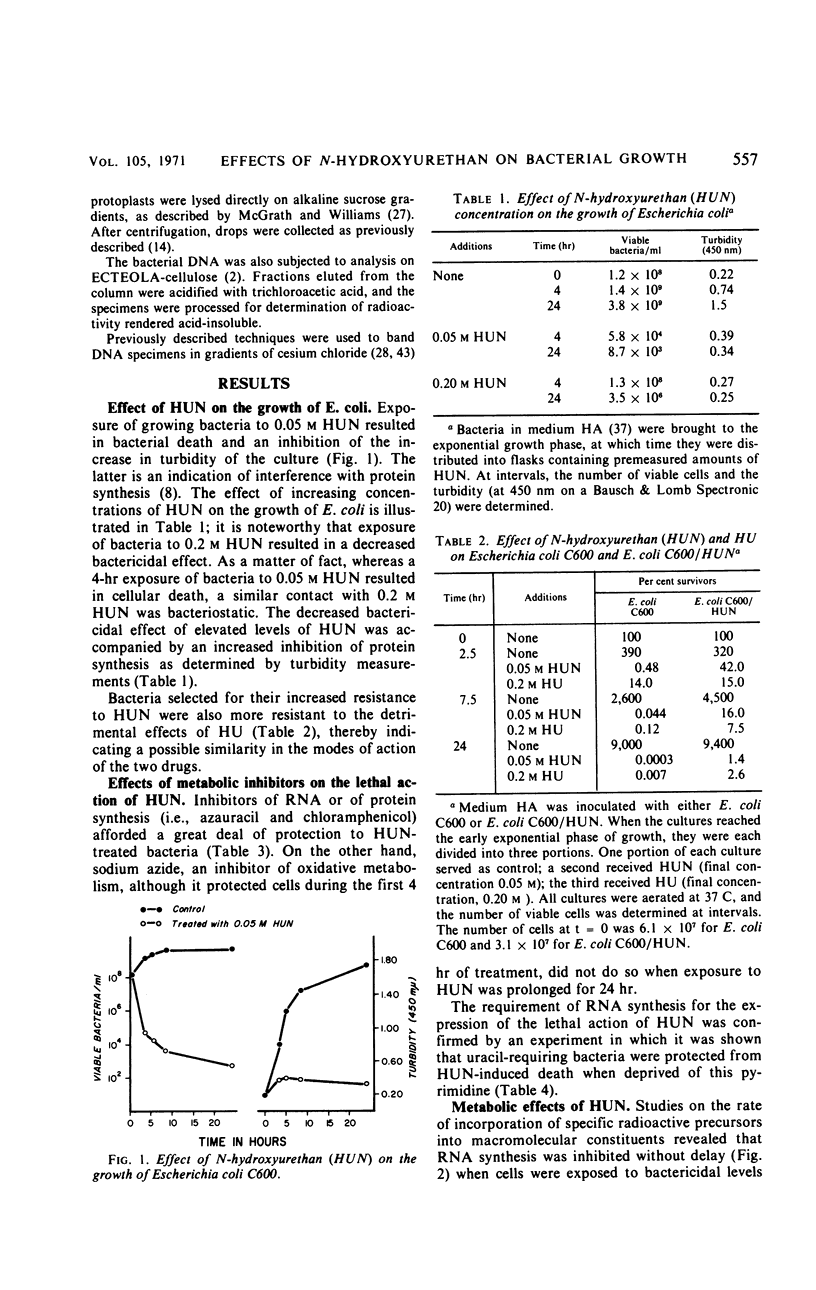
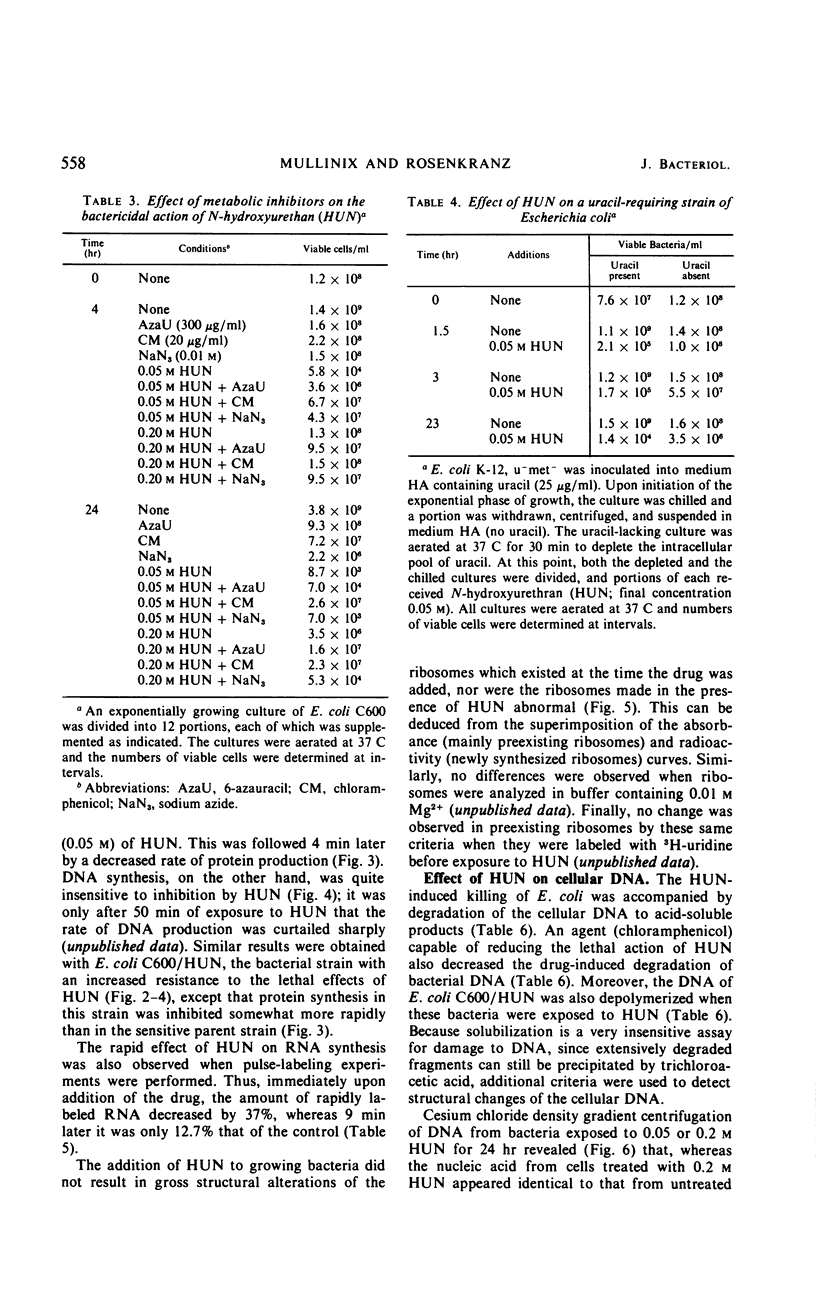
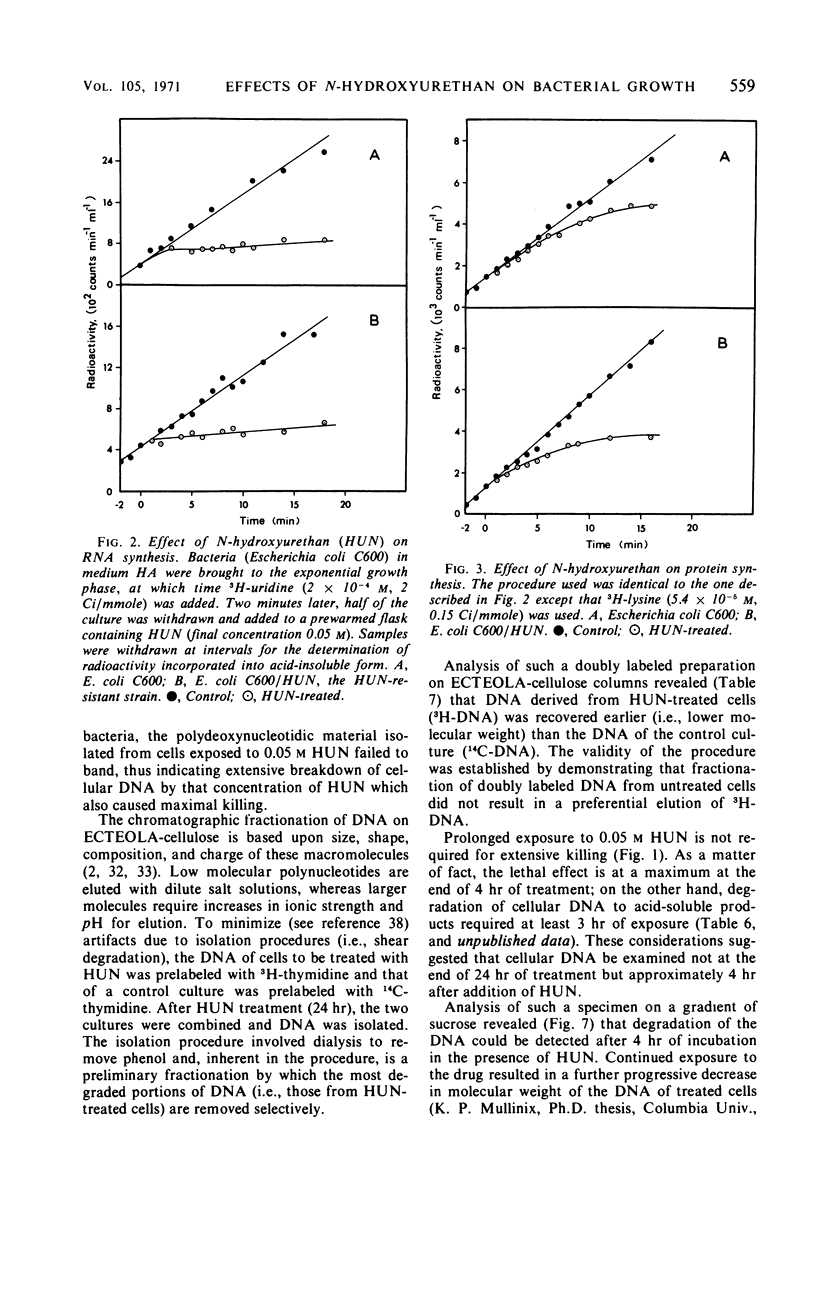
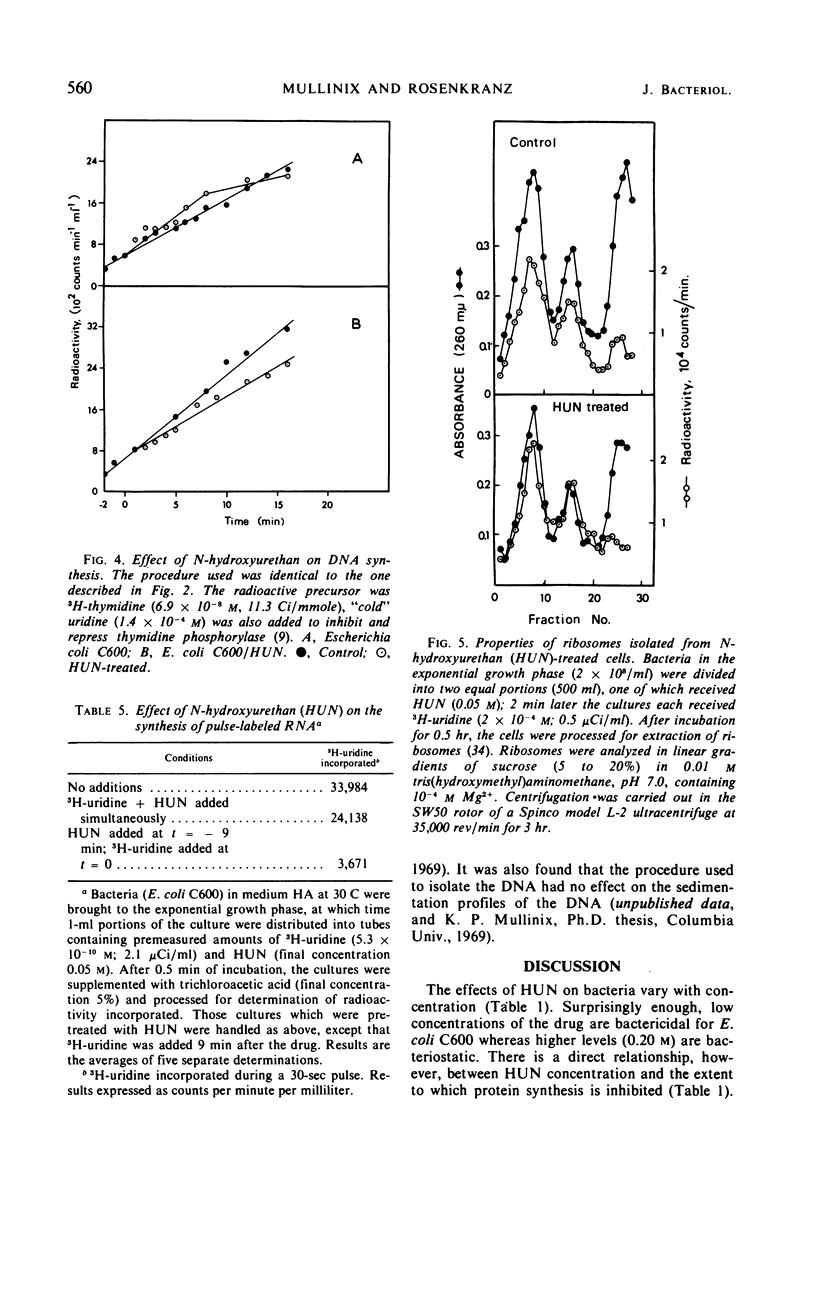
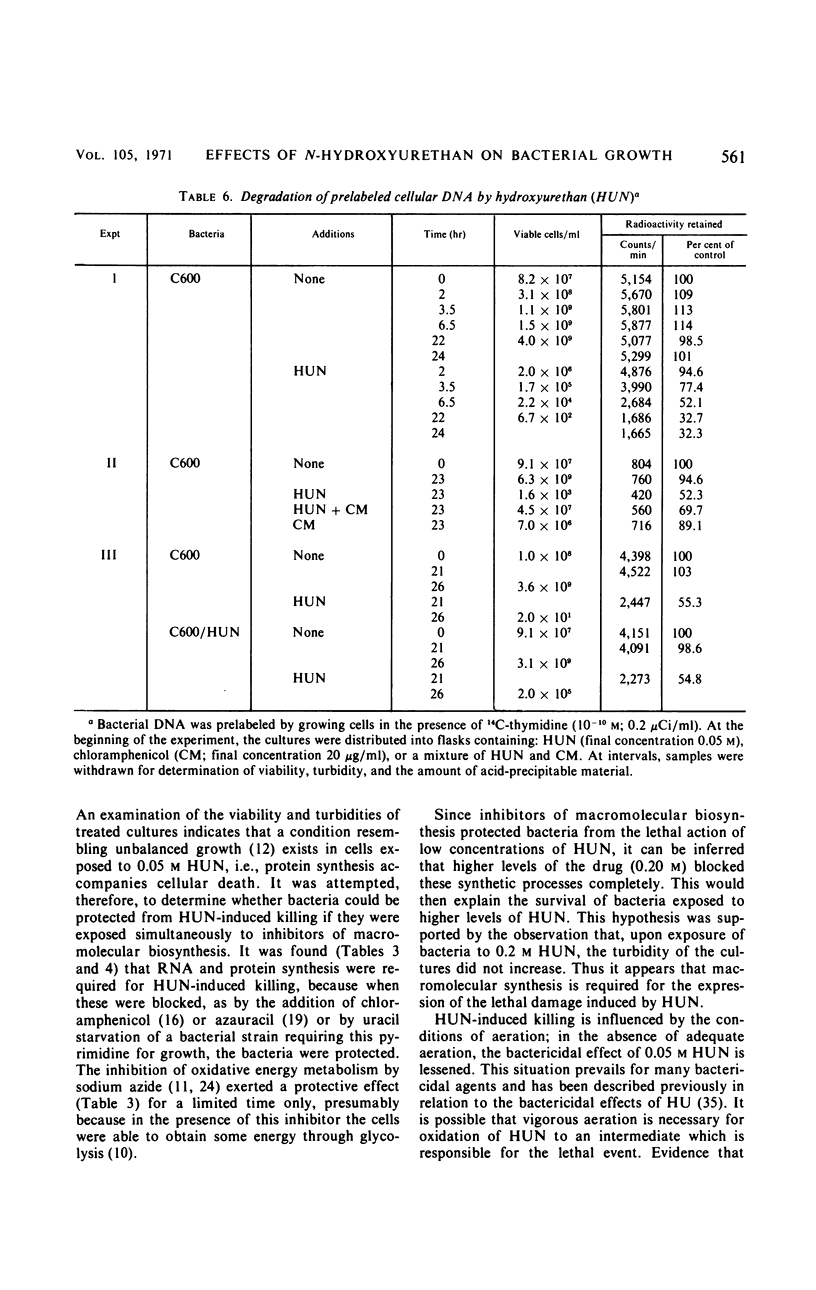
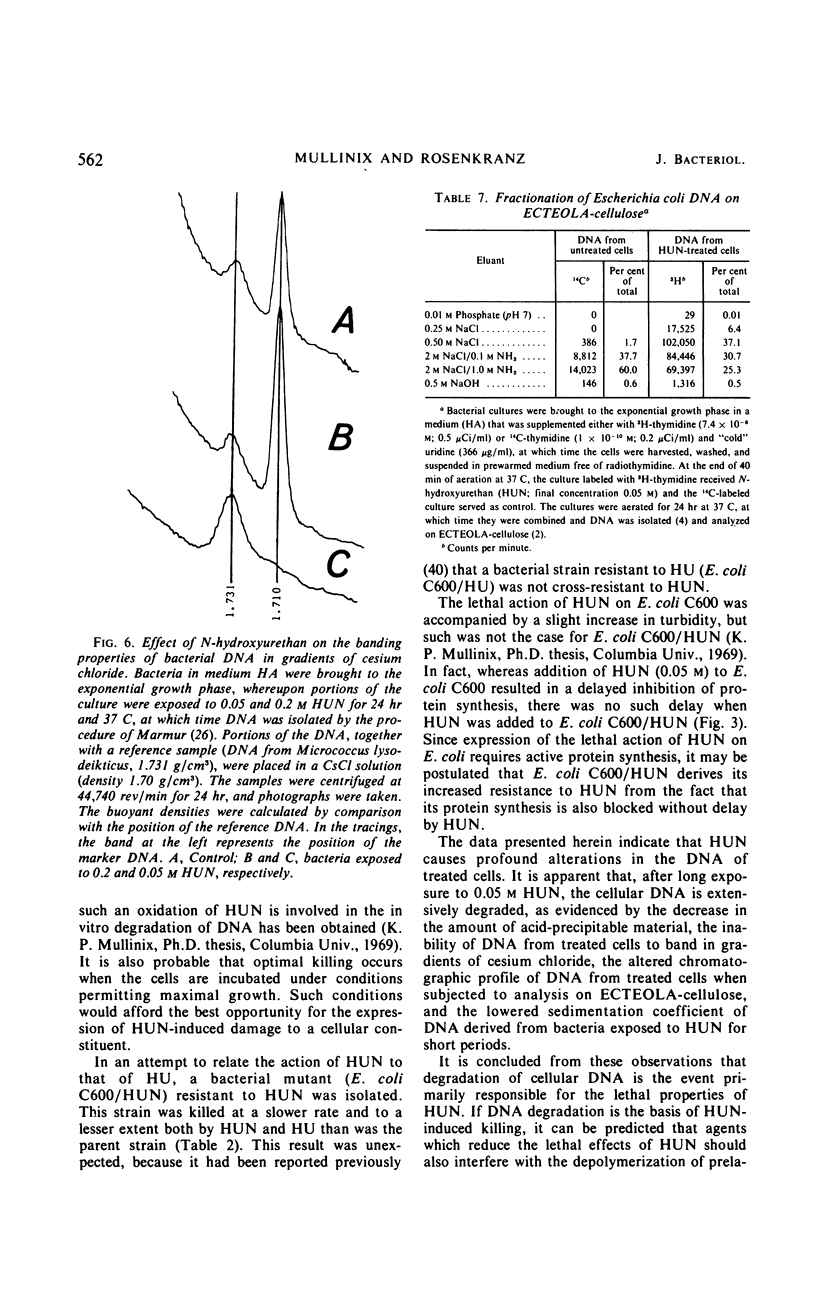
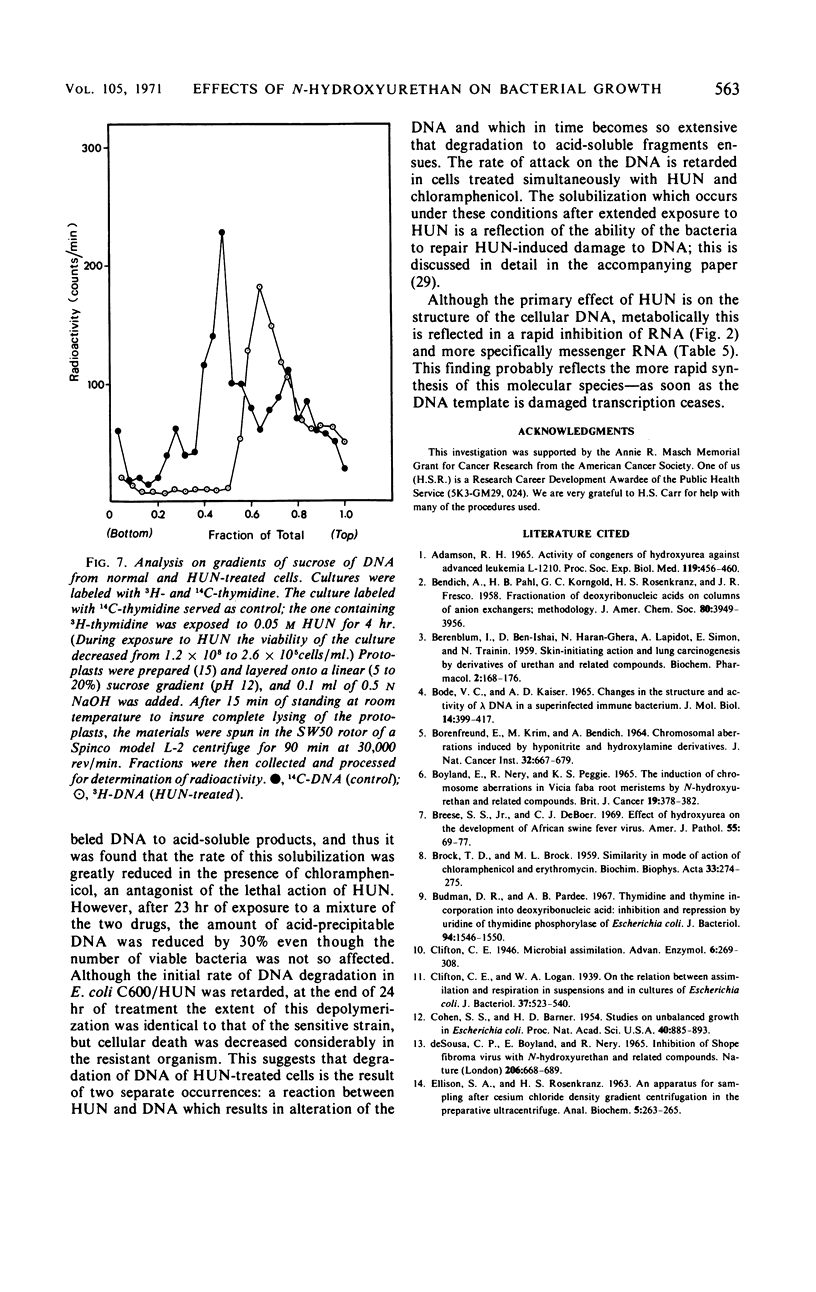
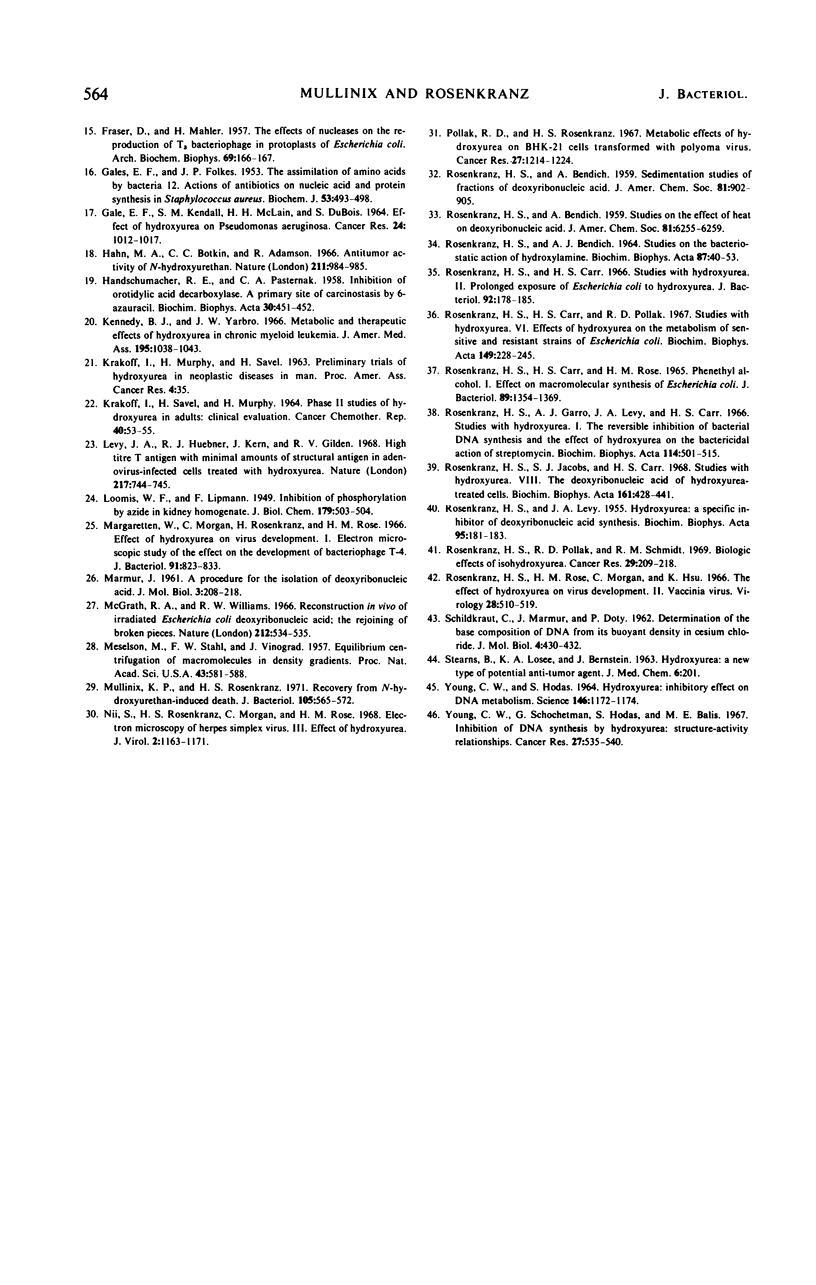
Selected References
These references are in PubMed. This may not be the complete list of references from this article.
- ADAMSON R. H. ACTIVITY OF CONGENERS OF HYDROXYUREA AGAINST ADVANCED LEUKEMIA L1210. Proc Soc Exp Biol Med. 1965 Jun;119:456–458. doi: 10.3181/00379727-119-30209. [DOI] [PubMed] [Google Scholar]
- BERENBLUM I., BEN-ISHAI D., HARAN-GHERA N., LAPIDOT A., SIMON E., TRAININ N. Skin initiating action and lung carcinogenesis byderivatives of urethane (ethyl carbamate) and related compounds. Biochem Pharmacol. 1959 Sep;2:168–176. doi: 10.1016/0006-2952(59)90065-6. [DOI] [PubMed] [Google Scholar]
- BORENFREUND E., KRIM M., BENDICH A. CHROMOSOMAL ABERRATIONS INDUCED BY HYPONITRITE AND HYDROXYLAMINE DERIVATIVES. J Natl Cancer Inst. 1964 Mar;32:667–679. [PubMed] [Google Scholar]
- BROCK T. D., BROCK M. L. Similarity in mode of action of chloramphenicol and erythromycin. Biochim Biophys Acta. 1959 May;33(1):274–275. doi: 10.1016/0006-3002(59)90535-9. [DOI] [PubMed] [Google Scholar]
- Bode V. C., Kaiser A. D. Changes in the structure and activity of lambda DNA in a superinfected immune bacterium. J Mol Biol. 1965 Dec;14(2):399–417. doi: 10.1016/s0022-2836(65)80190-5. [DOI] [PubMed] [Google Scholar]
- Breese S. S., Jr, DeBoer C. J. Effect of hydroxyurea on the development of African swine fever virus. Am J Pathol. 1969 Apr;55(1):69–77. [PMC free article] [PubMed] [Google Scholar]
- Budman D. R., Pardee A. B. Thymidine and thymine incorporation into deoxyribonucleic acid: inhibition and repression by uridine of thymidine phosphorylase of Escherichia coli. J Bacteriol. 1967 Nov;94(5):1546–1550. doi: 10.1128/jb.94.5.1546-1550.1967. [DOI] [PMC free article] [PubMed] [Google Scholar]
- Clifton C. E., Logan W. A. On the Relation between Assimilation and Respiration in Suspensions and in Cultures of Escherichia coli. J Bacteriol. 1939 May;37(5):523–540. doi: 10.1128/jb.37.5.523-540.1939. [DOI] [PMC free article] [PubMed] [Google Scholar]
- Cohen S. S., Barner H. D. STUDIES ON UNBALANCED GROWTH IN ESCHERICHIA COLI. Proc Natl Acad Sci U S A. 1954 Oct;40(10):885–893. doi: 10.1073/pnas.40.10.885. [DOI] [PMC free article] [PubMed] [Google Scholar]
- FRASER D., MAHLER H. R. The effects of nucleases on the reproduction of T3 bacteriophage in protoplasts of Escherichia coli. Arch Biochem Biophys. 1957 Jul;69:166–177. doi: 10.1016/0003-9861(57)90483-6. [DOI] [PubMed] [Google Scholar]
- GALE E. F., FOLKES J. P. The assimilation of amino-acids by bacteria. XV. Actions of antibiotics on nucleic acid and protein synthesis in Staphylococcus aureus. Biochem J. 1953 Feb;53(3):493–498. doi: 10.1042/bj0530493. [DOI] [PMC free article] [PubMed] [Google Scholar]
- GALE G. R., KENDALL S. M., MCLAIN H. H., DUBOIS S. EFFECT OF HYDROXYUREA ON PSEUDOMONAS AERUGINOSA. Cancer Res. 1964 Jul;24:1012–1020. [PubMed] [Google Scholar]
- HANDSCHUMACHER R. E., PASTERNAK C. A. Inhibition of orotidylic acid decarboxylase, a primary site of carcinostasis by 6-azauracil. Biochim Biophys Acta. 1958 Nov;30(2):451–452. doi: 10.1016/0006-3002(58)90088-x. [DOI] [PubMed] [Google Scholar]
- Hahn M. A., Botkin C. C., Adamson R. H. Antitumour activity of N-hydroxyurethane. Nature. 1966 Aug 27;211(5052):984–985. doi: 10.1038/211984a0. [DOI] [PubMed] [Google Scholar]
- KRAKOFF I. H., SAVEL H., MURPHY M. L. PHASE II STUDIES OF HYDROXYUREA (NSC-32065) IN ADULTS: CLINICAL EVALUATION. Cancer Chemother Rep. 1964 Aug;40:53–55. [PubMed] [Google Scholar]
- Kennedy B. J., Yarbro J. W. Metabolic and therapeutic effects of hydroxyurea in chronic myeloid leukemia. JAMA. 1966 Mar 21;195(12):1038–1043. [PubMed] [Google Scholar]
- Levy J. A., Huebner R. J., Kern J., Gilden R. V. High titre T antigen with minimal amounts of structural antigen in adenovirus-infected cells treated with hydroxyurea. Nature. 1968 Feb 24;217(5130):744–745. doi: 10.1038/217744a0. [DOI] [PubMed] [Google Scholar]
- Margaretten W., Morgan C., Rosenkranz H. S., Rose H. M. Effect of hydroxyurea on virus development. I. Electron microscopic study of the effect on the development of bacteriophage T4. J Bacteriol. 1966 Feb;91(2):823–833. doi: 10.1128/jb.91.2.823-833.1966. [DOI] [PMC free article] [PubMed] [Google Scholar]
- McGrath R. A., Williams R. W. Reconstruction in vivo of irradiated Escherichia coli deoxyribonucleic acid; the rejoining of broken pieces. Nature. 1966 Oct 29;212(5061):534–535. doi: 10.1038/212534a0. [DOI] [PubMed] [Google Scholar]
- Meselson M., Stahl F. W., Vinograd J. EQUILIBRIUM SEDIMENTATION OF MACROMOLECULES IN DENSITY GRADIENTS. Proc Natl Acad Sci U S A. 1957 Jul 15;43(7):581–588. doi: 10.1073/pnas.43.7.581. [DOI] [PMC free article] [PubMed] [Google Scholar]
- Mullinix K. P., Rosenkranz H. S. Recovery from N-hydroxyurethan-induced death. J Bacteriol. 1971 Feb;105(2):565–572. doi: 10.1128/jb.105.2.565-572.1971. [DOI] [PMC free article] [PubMed] [Google Scholar]
- Nii S., Rosenkranz H. S., Morgan C., Rose H. M. Electron microscopy of herpes simplex virus. 3. Effect of hydroxyurea. J Virol. 1968 Oct;2(10):1163–1171. doi: 10.1128/jvi.2.10.1163-1171.1968. [DOI] [PMC free article] [PubMed] [Google Scholar]
- Pollak R. D., Rosenkranz H. S. Metabolic effects of hydroxyurea on BHK-21 cells transformed with polyoma virus. Cancer Res. 1967 Jul;27(7):1214–1224. [PubMed] [Google Scholar]
- ROSENKRANZ H. S., BENDICH A. J. STUDIES ON THE BACTERIOSTATIC ACTION OF HYDROXYLAMINE. Biochim Biophys Acta. 1964 May 18;87:40–53. doi: 10.1016/0926-6550(64)90045-3. [DOI] [PubMed] [Google Scholar]
- ROSENKRANZ H. S., CARR H. S., ROSE H. M. PHENETHYL ALCOHOL. I. EFFECT ON MACROMOLECULAR SYNTHESIS OF ESCHERICHIA COLI. J Bacteriol. 1965 May;89:1354–1369. doi: 10.1128/jb.89.5.1354-1369.1965. [DOI] [PMC free article] [PubMed] [Google Scholar]
- ROSENKRANZ H. S., LEVY J. A. HYDROXYUREA: A SPECIFIC INHIBITOR OF DEOXYRIBONUCLEIC ACID SYNTHESIS. Biochim Biophys Acta. 1965 Jan 11;95:181–183. doi: 10.1016/0005-2787(65)90225-x. [DOI] [PubMed] [Google Scholar]
- Rosenkranz H. S., Carr H. S. Studies with hydroxyurea. II. Prolonged exposure of Escherichia coli to hydroxyurea. J Bacteriol. 1966 Jul;92(1):178–185. doi: 10.1128/jb.92.1.178-185.1966. [DOI] [PMC free article] [PubMed] [Google Scholar]
- Rosenkranz H. S., Garro A. J., Levy J. A., Carr H. S. Studies with hydroxyurea. I. The reversible inhibition of bacterial DNA synthesis and the effect of hydroxyurea on the bactericidal action of streptomycin. Biochim Biophys Acta. 1966 Mar 21;114(3):501–515. [PubMed] [Google Scholar]
- Rosenkranz H. S., Jacobs S. J., Carr H. S. Studies with hydroxyurea. 8. The deoxyribonucleic acid of hydroxyurea-treated cells. Biochim Biophys Acta. 1968 Jul 23;161(2):428–441. [PubMed] [Google Scholar]
- Rosenkranz H. S., Pollak R. D., Schmidt R. M. Biologic effects of isohydroxyurea. Cancer Res. 1969 Jan;29(1):209–218. [PubMed] [Google Scholar]
- Rosenkranz H. S., Rose H. M., Morgan C., Hsu K. C. The effect of hydroxyurea on virus development. II. Vaccinia virus. Virology. 1966 Apr;28(4):510–519. doi: 10.1016/0042-6822(66)90235-2. [DOI] [PubMed] [Google Scholar]
- Rosenkranz S., Carr H. S., Pollak R. D. Studies with hydroxyurea. VI. Effects of hydroxyurea on the metabolism of sensitive and resistant strains of Escherichia coli. Biochim Biophys Acta. 1967 Nov 21;149(1):228–245. doi: 10.1016/0005-2787(67)90704-6. [DOI] [PubMed] [Google Scholar]
- SCHILDKRAUT C. L., MARMUR J., DOTY P. Determination of the base composition of deoxyribonucleic acid from its buoyant density in CsCl. J Mol Biol. 1962 Jun;4:430–443. doi: 10.1016/s0022-2836(62)80100-4. [DOI] [PubMed] [Google Scholar]
- STEARNS B., LOSEE K. A., BERNSTEIN J. HYDROXYUREA. A NEW TYPE OF POTENTIAL ANTITUMOR AGENT. J Med Chem. 1963 Mar;6:201–201. doi: 10.1021/jm00338a026. [DOI] [PubMed] [Google Scholar]
- YOUNG C. W., HODAS S. HYDROXYUREA: INHIBITORY EFFECT ON DNA METABOLISM. Science. 1964 Nov 27;146(3648):1172–1174. doi: 10.1126/science.146.3648.1172. [DOI] [PubMed] [Google Scholar]
- Young C. W., Schochetman G., Hodas S., Balis M. E. Inhibition of DNA synthesis by hydroxyurea: structure-activity relationships. Cancer Res. 1967 Mar;27(3):535–540. [PubMed] [Google Scholar]
- de Sousa C. P., Boyland E., Nery R. Inhibition of Shope fibroma virus with N-hydroxyurethane and related compounds. Nature. 1965 May 15;206(985):688–689. doi: 10.1038/206688a0. [DOI] [PubMed] [Google Scholar]


